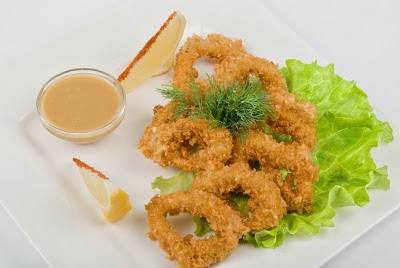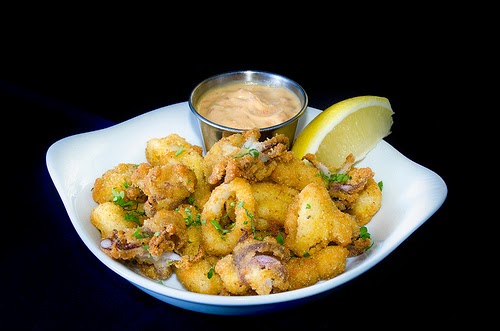from
Behind the French Menu
by
Bryan G. Newman
behindthefrenchmenu@gmail.com
The common cuttlefish
www.flickr.com/photos/wwarby/4695864776/
Seiche - Cuttlefish (Sùpi in Occitan) will be on menus all over mainland France and Encre de Seiche or Sépia, cuttlefish ink, will not only be coloring and flavoring risottos and pasta in restaurants but may be bought in the supermarkets for home cooks. All the fresh cuttlefish on restaurant menus will have been caught in the Mediterranean or the North Sea and those will rarely be more than 25 cm (10”) in length. Like calmar, calamari, (squid), a close cousin, cuttlefish have eight legs or tentacles, and two feelers, but the tastiest part of the cuttlefish is the Blanc de Seiche, the entirely white, tender meat from the head.
Cuttlefish was a beloved part of the Romans’ diet.
Detail of mosaic floor in the city of Herculaneum, Italy.
Herculaneum, like its sister city Pompeii, was destroyed by the eruption of
Mount Vesuvius in 79 C.E.
www.flickr.com/photos/70125105@N06/28918775427
Baby Cuttlefish - Supions, Supiouns, and Sepions
Baby cuttlefish are often prepared together with baby calamari, and while you may see the difference no one can taste them. However, adult cuttlefish have a more flavorful taste than calamari (but less so than those of their other cousin the octopus), and so they have their own recipes.
Supions en persillade
Baby cuttlefish prepared in a garlic and parsley sauce.
Encre de seiche - Cuttlefish ink.
In the kitchen, the color and taste of cuttlefish ink is an important ingredient, and from risottos to pasta, its color will be brightening the table. The ink is not black, but, rather like the name it gave to the color, sepia, it is a brown tinged with purple and in the kitchen, it will be added just before serving as cooked cuttlefish ink fades.
Cuttlefish on French menus:
Blanc de Seiche, Crème Infusée au Lard Fumé – The prepared white meat from the head of the cuttlefish served with a smoked bacon flavored cream sauce.
Blancs de seiche a la persillade
Cuttlefish heads in garlic and parsley sauce.
Brochette de Seiche et Chorizo Accompaniment Riz de Camargue - Skewers of cuttlefish and chorizo sausages accompanied by rice from the Camargue. The Camargue is an enormous natural biosphere in the Rhone River Delta in an area shared by the regions of Provence and Occitanie along the Mediterranean coast. Part of the Camargue is a working national park and famed both for the Taureaux de Camargue, its AOC/AOP beef cattle and its harvest of fruits and vegetables, especially its rice.
Maigre Sauvage, Risotto à l'Encre de Seiches, Navets et Radis Noirs Glacés au Bulldog - Wild Meagre, the fish, also called Croaker or Salmon Bass served with a risotto flavored and colored with cuttlefish ink and accompanied by turnips and black radishes glazed with Bulldog Gin.
Parillade de Poisson (Seiches, Moules, Saumon, Crevettes et Gambas) – A parillade of fish and seafood, (cuttlefish, mussels, salmon, and small and large shrimps). The originally Spanish parillada may be any assortment of fish, shellfish and or meat marinated in olive oil and grilled; the dish is usually accompanied by a persillade, a mixture of chopped parsley and garlic. A drizzle of virgin olive oil for flavor will often be added just before serving.
Saint Jacques Snackées, Spaghetti à l'Encre de Seiche, Crème de Maviar et Poutargue – Lightly seared meat from king scallops served with spaghetti flavored and colored with cuttlefish ink accompanied by a creamy sauce of maviar and poutargue. Maviar is caviar stand-in made with smoked cod eggs. Boutargue or Poutargue is the salted and dried roe of the gray mullet and a Provençal delicacy.
Poissons variés et riz à l'encre de seiche.
Fish with rice flavored with cuttlefish ink.
www.flickr.com/photos/lesphotosdejerome/7973276022/
Seiches Grillées à la Plancha, Coulis de Poivron Rouge - Cuttlefish grilled on the plancha and served with a thick sauce of red sweet peppers. The plancha, or planxa in Basque, is a heated thick iron sheet that provides a unique taste, somewhere between grilling and frying, as very little oil is used. Both the Spanish and the Basque claim the invention of the plancha and while cuttlefish will be on menus all over France in the Pays de Basque, the French Basque country it is almost a national dish.
Cuttlefish bone
Calmar, Calamari, (squid) and octopus have no bones, but the cuttlefish has a porous bone type material inside its head. This internal structure helps the cuttlefish rise and fall in the sea. The bone is often used for caged birds to peck at and get grit for their gizzards and it has other uses including that of a casting material for jewelry and small items.
Cuttlefish, grass, and bamboo treat on sale.
Cuttlefish ink.
Encre de seiche, cuttlefish ink, is much more highly valued for color and taste than the ink of calamari or octopuses which is usually discarded. The ink’s Roman/Latin name is sepia, and from Greek and Roman times the brown and purple tinted ink was used for writing, of course, is now associated with the color seen with white and brown images of early photography
Sepia photograph of a young woman
www.flickr.com/photos/simpleinsomnia/12906618504/
The cuttlefish name
Despite its English name, the cuttlefish is obviously not a fish. The name, according to Dictionary.com comes from the old English name for the species cudele which when added to fish became cuttlefish.
Large cuttlefish on sale in the Chinatown market Bangkok.
www.flickr.com/photos/68166820@N08/29024902148/
Cuttlefish in the languages of France’s neighbors:(Catalan - sipia), (Dutch - gewone Inktvis, zeekat), (german – tintenfisch, sepie), (Italian – seppia ), (Spanish - calamares), (Latin - sepia officinalis).
Connected Posts:
Searching for the meaning of words, names or phrases
on
French menus?
Just add the word, words, or phrase that you are searching for to the words "Behind the French Menu" and search with Google. Behind the French Menu’s links include hundreds of words, names, and phrases that are seen on French menus. There are over 450 articles that include over 4,000 French dishes with English translations and explanations.












